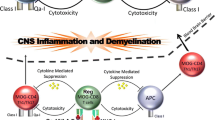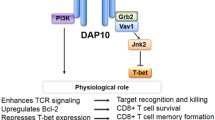Abstract
The NKG2D receptor costimulates effector/memory CD8 T cells and is normally absent on CD4 T cells but can be induced by T cell antigen receptor complex stimulation and interleukin-15 (IL-15). Among its ligands are the human major histocompatibility complex class I-related MICA and MICB, which have a restricted tissue distribution but are frequently associated with malignancies and some microbial infections. Moreover, aberrant expression of MIC may promote autoimmune disease progression. Human T cell lymphotropic virus type I (HTLV-1)-associated myelopathy/tropical spastic paraparesis (HAM/TSP) is a chronic inflammatory disease of the central nervous system that resembles multiple sclerosis. Disease progression involves production of IL-15 and its receptor through transactivation by the viral Tax regulator protein, an activated immune response state, and local cytokine production and T cell fratricide by Tax-specific cytotoxic T lymphocytes (CTL). This study shows that as with CD8 T cells, substantial proportions of HAM/TSP patient CD4 T cells are positive for NKG2D and that large numbers of T cells from both subsets express MIC, which can be transactivated by Tax independent of nuclear factor κB. Engagement of MIC by NKG2D promotes spontaneous HAM/TSP T cell proliferation and, apparently, CTL activities against HTLV-1-infected T cells. These results reveal a viral strategy that may exploit immune stimulatory mechanisms to negotiate a balance between promotion and limitation of infected host T cell expansions.




Similar content being viewed by others
References
Azimi N, Brown K, Bamford RN, Tagaya Y, Siebenlist U, Waldmann TA (1998) Human T cell lymphotropic virus type I Tax protein trans-activates interleukin-15 gene transcription through an NF-κB site. Proc Natl Acad Sci U S A 95:2452–2458
Azimi N, Jacobson S, Leist T, Waldmann TA (1999) Involvement of IL-15 in the pathogenesis of human T lymphotropic virus type I-associated myelopathy/tropical spastic paraparesis: implications for therapy with a monoclonal antibody directed to the IL-2/15R beta receptor. J Immunol 163:4064–4072
Azimi N, Nagai M, Jacobson S, Waldmann TA (2001) IL-15 plays a major role in the persistence of the Tax-specific CD8 cells in HAM/TSP patients. Proc Natl Acad Sci U S A 98:14559–14564
Bauer S, Groh V, Wu J, Steinle A, Phillips JH, Lanier LL, Spies T (1999) Activation of NK cells and T cells by NKG2D, a receptor for stress-inducible MICA. Science 285:727–729
Corss SL, Feinberg ML, Wolf JB, Holbrook NJ, Wong-Staal F, Leonard WJ (1987) Regulation of the human interleukin-2 receptor alpha chain promoter: activation of a nonfunctional promoter by the transactivator gene of HTLV-I. Cell 49:47–56
Das H, Groh V, Kuijl C, Sugita M, Morita CT, Spies T, Bukowski JF (2001) MICA engagement by human Vγ2Vδ2 T cells enhances their antigen-dependent effector function. Immunity 15:83–93
Doubrovina ES, Doubrovin MM, Vider E, Sisson RB, O’Reilly RJ, Dupont B, Vyas YM (2003) Evasion from NK cell immunity by MHC class I chain-related molecules expressing colon carcinoma. J Immunol 171:6891–6899
Franchini G (1995) Molecular mechanisms of human T-cell leukemia/lymphotropic virus type I infection. Blood 86:3619–3639
Gonzales S, Groh V, Spies T (2006) Immunobiology of human NKG2D and its ligands. Curr Top Microbiol Immunol 298:121–138
Groh V, Rhinehart R, Secrist H, Bauer S, Grabstein KH, Spies T (1999) Broad tumor-associated expression and recognition by tumor-derived γδ T cells of MICA and MICB. Proc Natl Acad Sci U S A 96:6879–6884
Groh V, Rhinehart R, Randolph-Habecker J, Topp MS, Riddell SR, Spies T (2001) Costimulation of CD8 αβ T cells by NKG2D via engagement by MIC induced on virus-infected cells. Nat Immunol 2:255–260
Groh V, Wu J, Yee C, Spies T (2002) Tumour-derived soluble MIC ligands impair expression of NKG2D and T cell activation. Nature 419:734–738
Groh V, Brühl A, El-Gabalawy H, Nelson JL, Spies T (2003) Stimulation of T cell autoreactivity by anomalous expression of NKG2D and its MIC ligands in rheumatoid arthritis. Proc Natl Acad Sci U S A 100:9452–9457
Hanon E, Stinchcombe JC, Saito M, Asquith BE, Taylor G, Tanaka Y, Weber JN, Griffiths GM, Bangham CRM (2000a) Fratricide among CD8 T lymphocytes naturally infected with human T cell lymphotropic virus type I. Immunity 13:657–664
Hanon E, Hall S, Taylor G, Saito M, Davis R, Tanaka Y, Usuku K, Osame M, Weber J, Bangham CRM (2000b) Abundant Tax protein expression in CD4+ T cells infected with human T-cell leukemia virus type I (HTLV-I) is prevented by cytotoxic T lymphocytes. Blood 95:1386–1392
Hollsberg P, Hafler DA (1993) Pathogenesis of diseases induced by human lymphotropic virus type I infection. N Engl J Med 328:1173–1176
Itoyama Y, Minato S, Kira J, Gotot I, Sato H, Ikochi K, Yamamoto N (1988) Spontaneous proliferation of peripheral blood lymphocytes increases in patients with HTLV-I associated myelopathy. Neurology 38:816–821
Jacobson S, Shida H, McFarlin DE, Fauci AS, Koenig S (1990) Circulating CD8+ cytotoxic T lymphocytes specific for HTLV-I pX in patients with HTLV-I associated neurological disease. Nature 348:245–248
Lee B, Tanaka Y, Tozawa H (1989) Monoclonal antibody defining tax protein of human T-cell leukemia virus type-1. Tohuko J Exp Med 157:1–11
Lehky TJ, Fox CH, Koenig S, Levin MC, Flerlage N, Izumo S, Sato E, Raine CS, Osame M, Jacobson S (1995) Detection of human T lymphotropic virus type I (HTLV-1) Tax RNA in the central nervous system of HTLV-1 associated myelopathy/tropical spastic paraparesis by in situ hybridization. Ann Neurol 37:246–252
Lu H, Pise-Masison CA, Linton R, Park HU, Schilz RL, Sartorelli V, Brady JN (2004) Tax relieves transcriptional repression by promoting histone deacetylase 1 release from the human T-cell leukemia virus type 1 long terminal repeat. J Virol 78:6735–6743
Mariner JM, Lantz V, Waldmann TA, Azimi N (2001) Human T cell lymphotropic virus type I Tax activates IL-15R alpha gene expression through an NF-kappa B site. J Immunol 166:2602–2609
Mariner JM, Mamane Y, Hiscott J, Waldmann TA, Azimi N (2002) IFN regulatory factor 4 participates in the human T cell lymphotropic virus type I-mediated activation of the IL-15 receptor alpha promoter. J Immunol 168:5667–5674
Meresse B, Chen Z, Ciszewski C, Tretiakova M, Bhagat G, Krausz TN, Raulet DH, Lanier LL, Groh V, Spies T, Ebert EC, Green PH, Jabri B (2004) Coordinated induction by IL-15 of a TCR-independent pathway converts CTL into lymphokine-activated killer cells in celiac disease. Immunity 21:357–366
Ogasawara K, Hamerman JA, Ehrlich LR, Bour-Jordan H, Santamaria P, Bluestone JA, Lanier LL (2004) NKG2D blockade prevents autoimmune diabetes in NOD mice. Immunity 20:757–767
Ohanti K, Nakamura M, Saito S, Sugamura K, Hinuma Y (1989) Electroporation: application to human lymphoid cell lines for stable introduction of a transactivator gene of human T-cell leukemia virus type I. Nucleic Acids Res 17:1589–1604
Osame M, Usuku K, Izumo N, Ijichi N, Amitani A, Matsumoto M, Tara M (1986) HTLV-I associated myelopathy, a new clinical entity. Lancet 1:1031–1035
Parham P, Barnstable CJ, Bodmer WF (1979) Use of a monoclonal antibody (W6/32) in structural studies of HLA-A, B, C antigens. J Immunol 123:342–349
Parker CE, Nightingale S, Taylor GP, Weber J, Bangham CRM (1994) Circulating anti-Tax cytotoxic T lymphocytes from human T-cell leukemia virus type I-infected people, with and without tropical spastic paraparesis, recognizing multiple epitopes simultaneously. J Virol 68:2860–2868
Roberts AI, Lee L, Schwartz E, Groh V, Spies T, Ebert EC, Jabri B (2001) NKG2D receptors induced by IL-15 costimulate CD28-negative effector CTL in the tissue microenvironment. J Immunol 167:5527–5530
Uchiyama T (1997) Human T cell leukemia virus type I (HTLV-I) and human diseases. Annu Rev Immunol 15:15–37
Wu J, Song Y, Bakker ABH, Bauer S, Spies T, Lanier LL, Phillips JH (1999) An activating immunoreceptor complex formed by NKG2D and DAP10. Science 285:730–732
Yamano Y, Takenouchi N, Li H-C, Tomaru U, Yao K, Grant CW, Maric DA, Jacobson S (2005) Virus-induced dysfunction of CD4+CD25+ T cells in patients with HTLV-1-associated neuroimmunologic disease. J Clin Invest 115:1361–1368
Zhang X, Siquan S, Hwang I, Tough DF, Sprent J (1998) Potent and selective stimulation of memory-phenotype CD8+ T cells in vivo by IL-15. Immunity 8:591–597
Acknowledgements
This work was supported by National Institutes of Health grants AI042528 (L.C.) and AI30581 and AI52319 (T.S.). All experiments comply with current laws of the USA.
Author information
Authors and Affiliations
Corresponding author
Rights and permissions
About this article
Cite this article
Azimi, N., Jacobson, S., Tanaka, Y. et al. Immunostimulation by induced expression of NKG2D and its MIC ligands in HTLV-1-associated neurologic disease. Immunogenetics 58, 252–258 (2006). https://doi.org/10.1007/s00251-006-0082-9
Received:
Accepted:
Published:
Issue Date:
DOI: https://doi.org/10.1007/s00251-006-0082-9




